Financial Reporting Analysis: Assessing GWA Group Limited's Reports
VerifiedAdded on 2021/05/31
|14
|2227
|111
Report
AI Summary
This report provides a detailed analysis of the financial statements of GWA Group Limited, evaluating their compliance with accounting standards. It examines provisions and contingencies, including guarantees and capital expenditure commitments, discussing their recognition criteria and measurement issues. The report explores arguments for and against recording contingencies in financial statements, highlighting their impact on qualitative characteristics. It also delves into the details of leased items, their classification, and presentation requirements, including reclassification scenarios. Furthermore, the report assesses the valuation methods of non-current assets, specifically focusing on intangible assets and alternative valuation approaches like the income approach, concluding with an evaluation of the overall quality of GWA Group Limited's financial reporting and the importance of adequate disclosures.
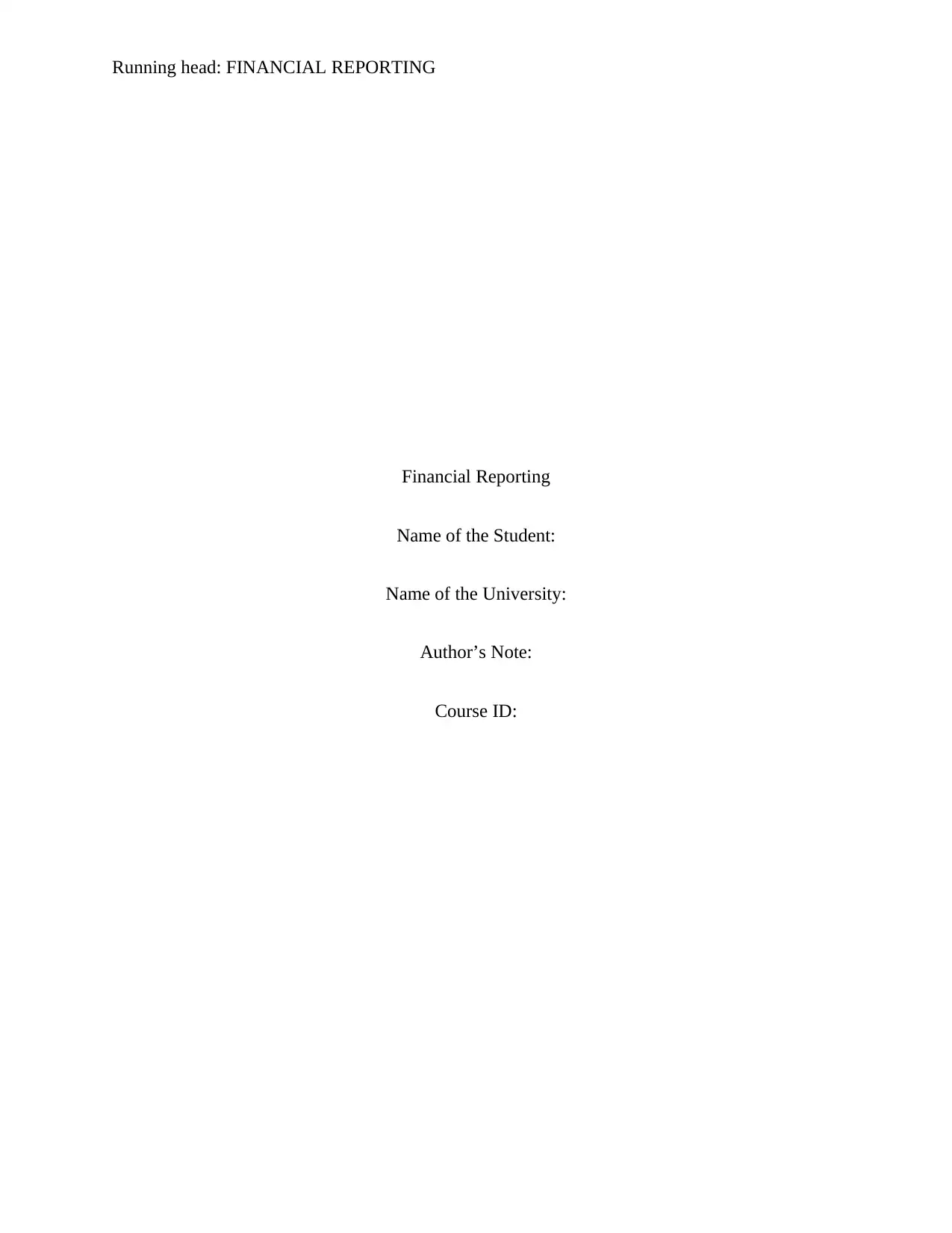
Running head: FINANCIAL REPORTING
Financial Reporting
Name of the Student:
Name of the University:
Author’s Note:
Course ID:
Financial Reporting
Name of the Student:
Name of the University:
Author’s Note:
Course ID:
Paraphrase This Document
Need a fresh take? Get an instant paraphrase of this document with our AI Paraphraser
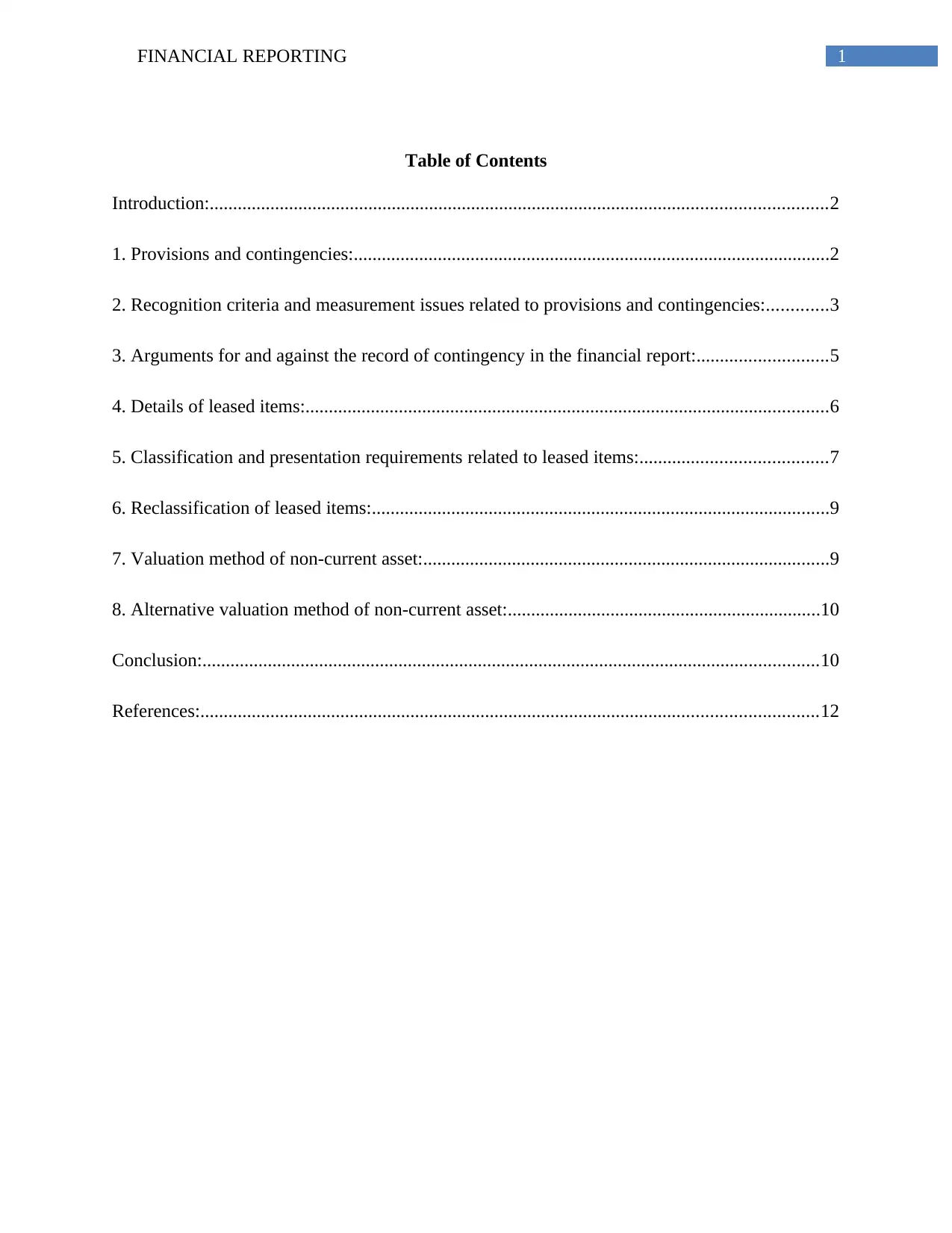
1FINANCIAL REPORTING
Table of Contents
Introduction:....................................................................................................................................2
1. Provisions and contingencies:......................................................................................................2
2. Recognition criteria and measurement issues related to provisions and contingencies:.............3
3. Arguments for and against the record of contingency in the financial report:............................5
4. Details of leased items:................................................................................................................6
5. Classification and presentation requirements related to leased items:........................................7
6. Reclassification of leased items:..................................................................................................9
7. Valuation method of non-current asset:.......................................................................................9
8. Alternative valuation method of non-current asset:...................................................................10
Conclusion:....................................................................................................................................10
References:....................................................................................................................................12
Table of Contents
Introduction:....................................................................................................................................2
1. Provisions and contingencies:......................................................................................................2
2. Recognition criteria and measurement issues related to provisions and contingencies:.............3
3. Arguments for and against the record of contingency in the financial report:............................5
4. Details of leased items:................................................................................................................6
5. Classification and presentation requirements related to leased items:........................................7
6. Reclassification of leased items:..................................................................................................9
7. Valuation method of non-current asset:.......................................................................................9
8. Alternative valuation method of non-current asset:...................................................................10
Conclusion:....................................................................................................................................10
References:....................................................................................................................................12
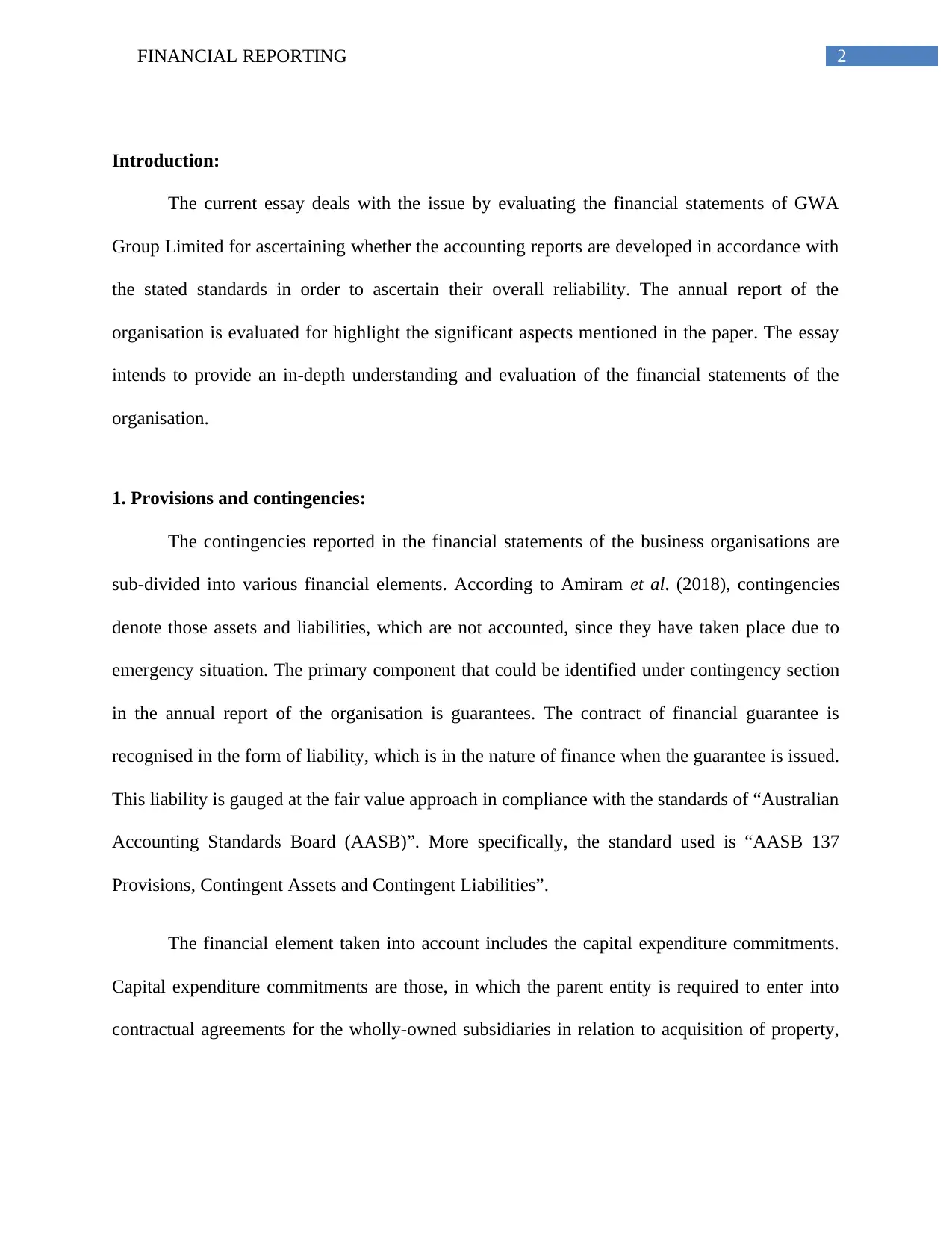
2FINANCIAL REPORTING
Introduction:
The current essay deals with the issue by evaluating the financial statements of GWA
Group Limited for ascertaining whether the accounting reports are developed in accordance with
the stated standards in order to ascertain their overall reliability. The annual report of the
organisation is evaluated for highlight the significant aspects mentioned in the paper. The essay
intends to provide an in-depth understanding and evaluation of the financial statements of the
organisation.
1. Provisions and contingencies:
The contingencies reported in the financial statements of the business organisations are
sub-divided into various financial elements. According to Amiram et al. (2018), contingencies
denote those assets and liabilities, which are not accounted, since they have taken place due to
emergency situation. The primary component that could be identified under contingency section
in the annual report of the organisation is guarantees. The contract of financial guarantee is
recognised in the form of liability, which is in the nature of finance when the guarantee is issued.
This liability is gauged at the fair value approach in compliance with the standards of “Australian
Accounting Standards Board (AASB)”. More specifically, the standard used is “AASB 137
Provisions, Contingent Assets and Contingent Liabilities”.
The financial element taken into account includes the capital expenditure commitments.
Capital expenditure commitments are those, in which the parent entity is required to enter into
contractual agreements for the wholly-owned subsidiaries in relation to acquisition of property,
Introduction:
The current essay deals with the issue by evaluating the financial statements of GWA
Group Limited for ascertaining whether the accounting reports are developed in accordance with
the stated standards in order to ascertain their overall reliability. The annual report of the
organisation is evaluated for highlight the significant aspects mentioned in the paper. The essay
intends to provide an in-depth understanding and evaluation of the financial statements of the
organisation.
1. Provisions and contingencies:
The contingencies reported in the financial statements of the business organisations are
sub-divided into various financial elements. According to Amiram et al. (2018), contingencies
denote those assets and liabilities, which are not accounted, since they have taken place due to
emergency situation. The primary component that could be identified under contingency section
in the annual report of the organisation is guarantees. The contract of financial guarantee is
recognised in the form of liability, which is in the nature of finance when the guarantee is issued.
This liability is gauged at the fair value approach in compliance with the standards of “Australian
Accounting Standards Board (AASB)”. More specifically, the standard used is “AASB 137
Provisions, Contingent Assets and Contingent Liabilities”.
The financial element taken into account includes the capital expenditure commitments.
Capital expenditure commitments are those, in which the parent entity is required to enter into
contractual agreements for the wholly-owned subsidiaries in relation to acquisition of property,
⊘ This is a preview!⊘
Do you want full access?
Subscribe today to unlock all pages.

Trusted by 1+ million students worldwide
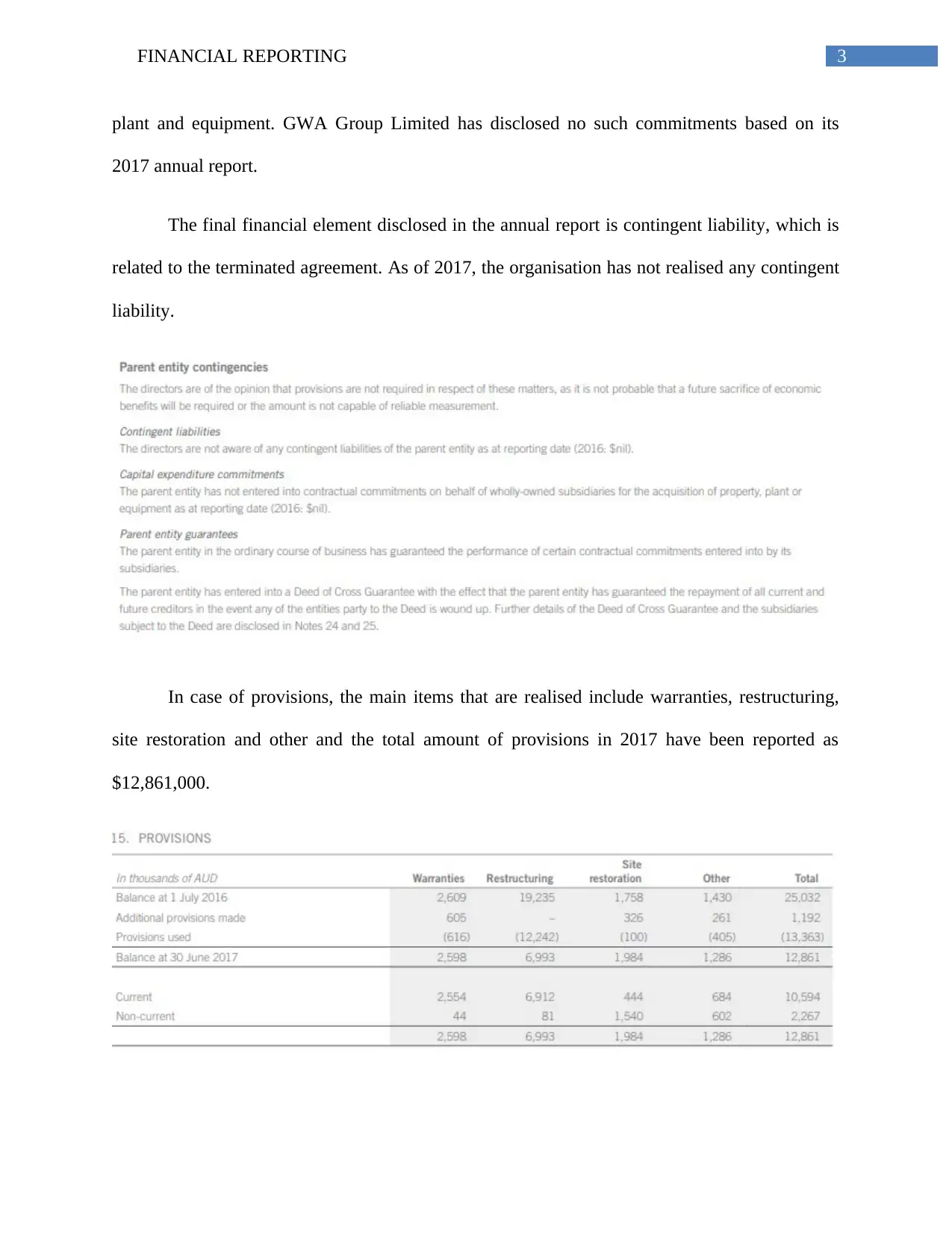
3FINANCIAL REPORTING
plant and equipment. GWA Group Limited has disclosed no such commitments based on its
2017 annual report.
The final financial element disclosed in the annual report is contingent liability, which is
related to the terminated agreement. As of 2017, the organisation has not realised any contingent
liability.
In case of provisions, the main items that are realised include warranties, restructuring,
site restoration and other and the total amount of provisions in 2017 have been reported as
$12,861,000.
plant and equipment. GWA Group Limited has disclosed no such commitments based on its
2017 annual report.
The final financial element disclosed in the annual report is contingent liability, which is
related to the terminated agreement. As of 2017, the organisation has not realised any contingent
liability.
In case of provisions, the main items that are realised include warranties, restructuring,
site restoration and other and the total amount of provisions in 2017 have been reported as
$12,861,000.
Paraphrase This Document
Need a fresh take? Get an instant paraphrase of this document with our AI Paraphraser
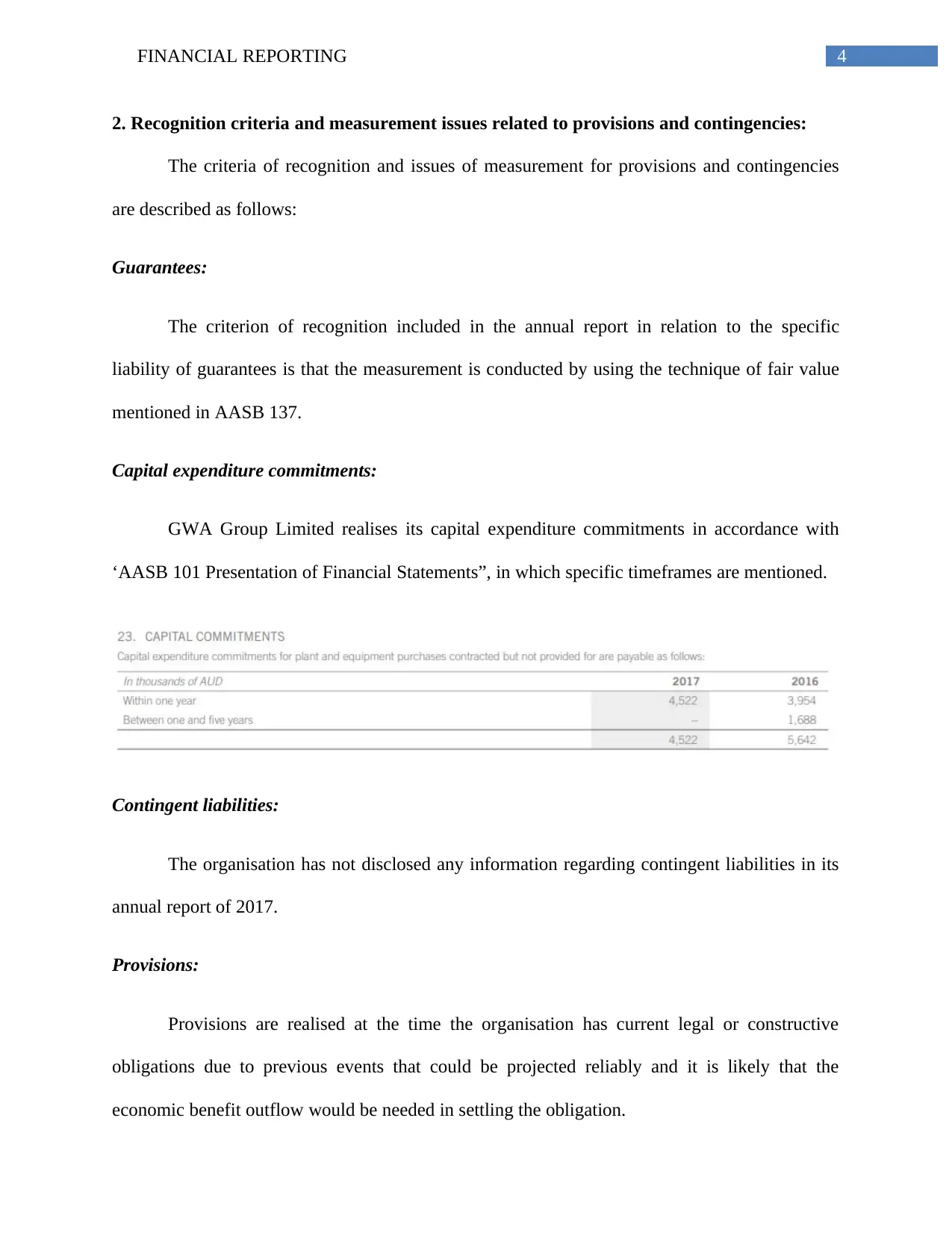
4FINANCIAL REPORTING
2. Recognition criteria and measurement issues related to provisions and contingencies:
The criteria of recognition and issues of measurement for provisions and contingencies
are described as follows:
Guarantees:
The criterion of recognition included in the annual report in relation to the specific
liability of guarantees is that the measurement is conducted by using the technique of fair value
mentioned in AASB 137.
Capital expenditure commitments:
GWA Group Limited realises its capital expenditure commitments in accordance with
‘AASB 101 Presentation of Financial Statements”, in which specific timeframes are mentioned.
Contingent liabilities:
The organisation has not disclosed any information regarding contingent liabilities in its
annual report of 2017.
Provisions:
Provisions are realised at the time the organisation has current legal or constructive
obligations due to previous events that could be projected reliably and it is likely that the
economic benefit outflow would be needed in settling the obligation.
2. Recognition criteria and measurement issues related to provisions and contingencies:
The criteria of recognition and issues of measurement for provisions and contingencies
are described as follows:
Guarantees:
The criterion of recognition included in the annual report in relation to the specific
liability of guarantees is that the measurement is conducted by using the technique of fair value
mentioned in AASB 137.
Capital expenditure commitments:
GWA Group Limited realises its capital expenditure commitments in accordance with
‘AASB 101 Presentation of Financial Statements”, in which specific timeframes are mentioned.
Contingent liabilities:
The organisation has not disclosed any information regarding contingent liabilities in its
annual report of 2017.
Provisions:
Provisions are realised at the time the organisation has current legal or constructive
obligations due to previous events that could be projected reliably and it is likely that the
economic benefit outflow would be needed in settling the obligation.
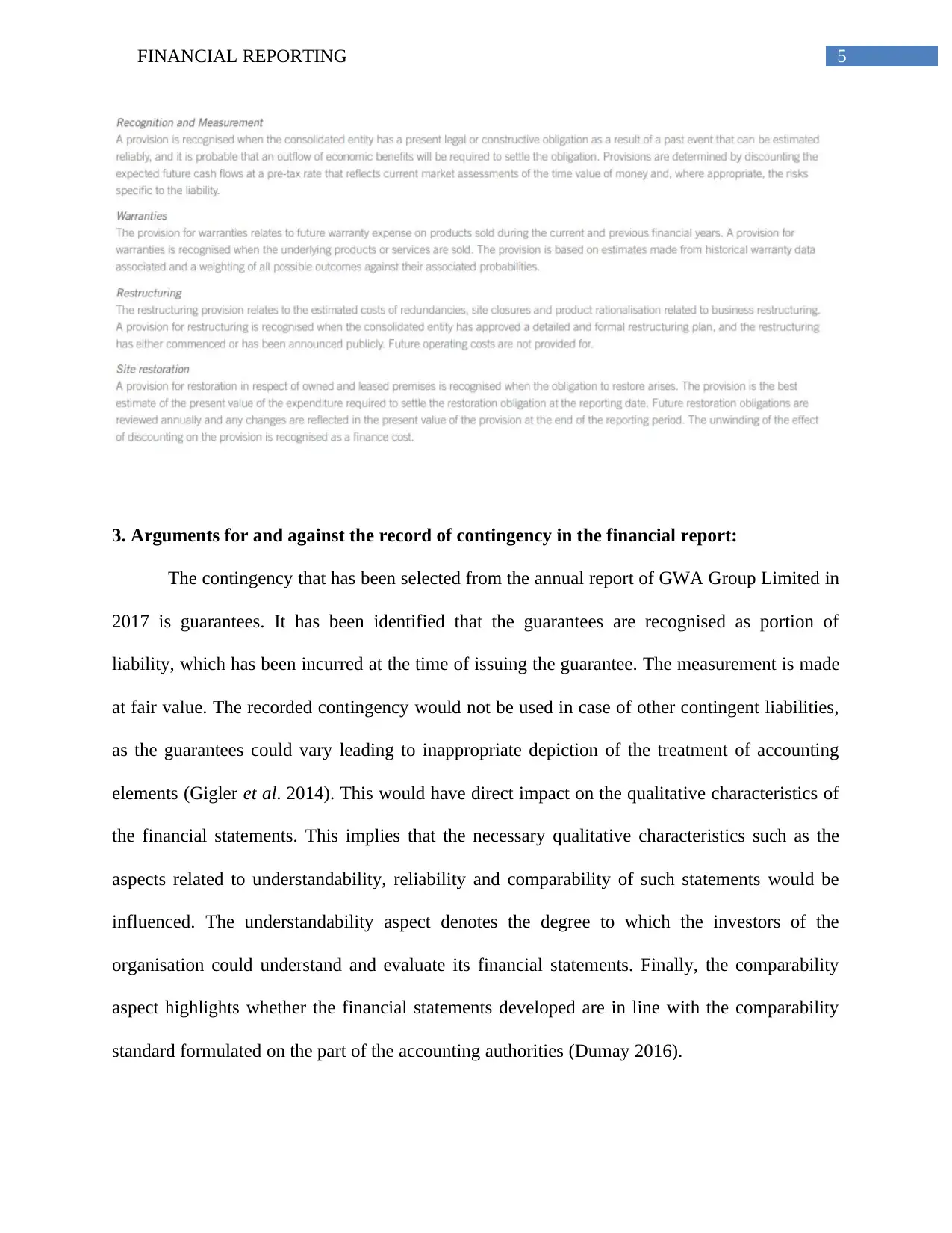
5FINANCIAL REPORTING
3. Arguments for and against the record of contingency in the financial report:
The contingency that has been selected from the annual report of GWA Group Limited in
2017 is guarantees. It has been identified that the guarantees are recognised as portion of
liability, which has been incurred at the time of issuing the guarantee. The measurement is made
at fair value. The recorded contingency would not be used in case of other contingent liabilities,
as the guarantees could vary leading to inappropriate depiction of the treatment of accounting
elements (Gigler et al. 2014). This would have direct impact on the qualitative characteristics of
the financial statements. This implies that the necessary qualitative characteristics such as the
aspects related to understandability, reliability and comparability of such statements would be
influenced. The understandability aspect denotes the degree to which the investors of the
organisation could understand and evaluate its financial statements. Finally, the comparability
aspect highlights whether the financial statements developed are in line with the comparability
standard formulated on the part of the accounting authorities (Dumay 2016).
3. Arguments for and against the record of contingency in the financial report:
The contingency that has been selected from the annual report of GWA Group Limited in
2017 is guarantees. It has been identified that the guarantees are recognised as portion of
liability, which has been incurred at the time of issuing the guarantee. The measurement is made
at fair value. The recorded contingency would not be used in case of other contingent liabilities,
as the guarantees could vary leading to inappropriate depiction of the treatment of accounting
elements (Gigler et al. 2014). This would have direct impact on the qualitative characteristics of
the financial statements. This implies that the necessary qualitative characteristics such as the
aspects related to understandability, reliability and comparability of such statements would be
influenced. The understandability aspect denotes the degree to which the investors of the
organisation could understand and evaluate its financial statements. Finally, the comparability
aspect highlights whether the financial statements developed are in line with the comparability
standard formulated on the part of the accounting authorities (Dumay 2016).
⊘ This is a preview!⊘
Do you want full access?
Subscribe today to unlock all pages.

Trusted by 1+ million students worldwide

6FINANCIAL REPORTING
4. Details of leased items:
Property, plant and equipment under financial leases are disclosed in the annual report of
GWA Group Limited having amount of $10,493,000 in 2017 in contrast to $11,281,000 in 2016.
In addition, it could be identified from the annual report of the organisation that the rental
expenses with regards to operating leases have been segregated into three different timeframes,
which include below one year, between one year and five years and above five years. The rental
expenses have been reported as $72,129,000 in 2017 compared to $33,366,000 in 2016. The
lease liabilities that the organisation has realised in 2017 are observed as $15,276,000, which
were $16,189,000 in 2016 (Gwagroup.com.au 2018). For recognising leases in the annual report
of the organisation, GWA Group Limited has disclosed its lease payments in accordance with
“AASB 16 Leases”.
4. Details of leased items:
Property, plant and equipment under financial leases are disclosed in the annual report of
GWA Group Limited having amount of $10,493,000 in 2017 in contrast to $11,281,000 in 2016.
In addition, it could be identified from the annual report of the organisation that the rental
expenses with regards to operating leases have been segregated into three different timeframes,
which include below one year, between one year and five years and above five years. The rental
expenses have been reported as $72,129,000 in 2017 compared to $33,366,000 in 2016. The
lease liabilities that the organisation has realised in 2017 are observed as $15,276,000, which
were $16,189,000 in 2016 (Gwagroup.com.au 2018). For recognising leases in the annual report
of the organisation, GWA Group Limited has disclosed its lease payments in accordance with
“AASB 16 Leases”.
Paraphrase This Document
Need a fresh take? Get an instant paraphrase of this document with our AI Paraphraser
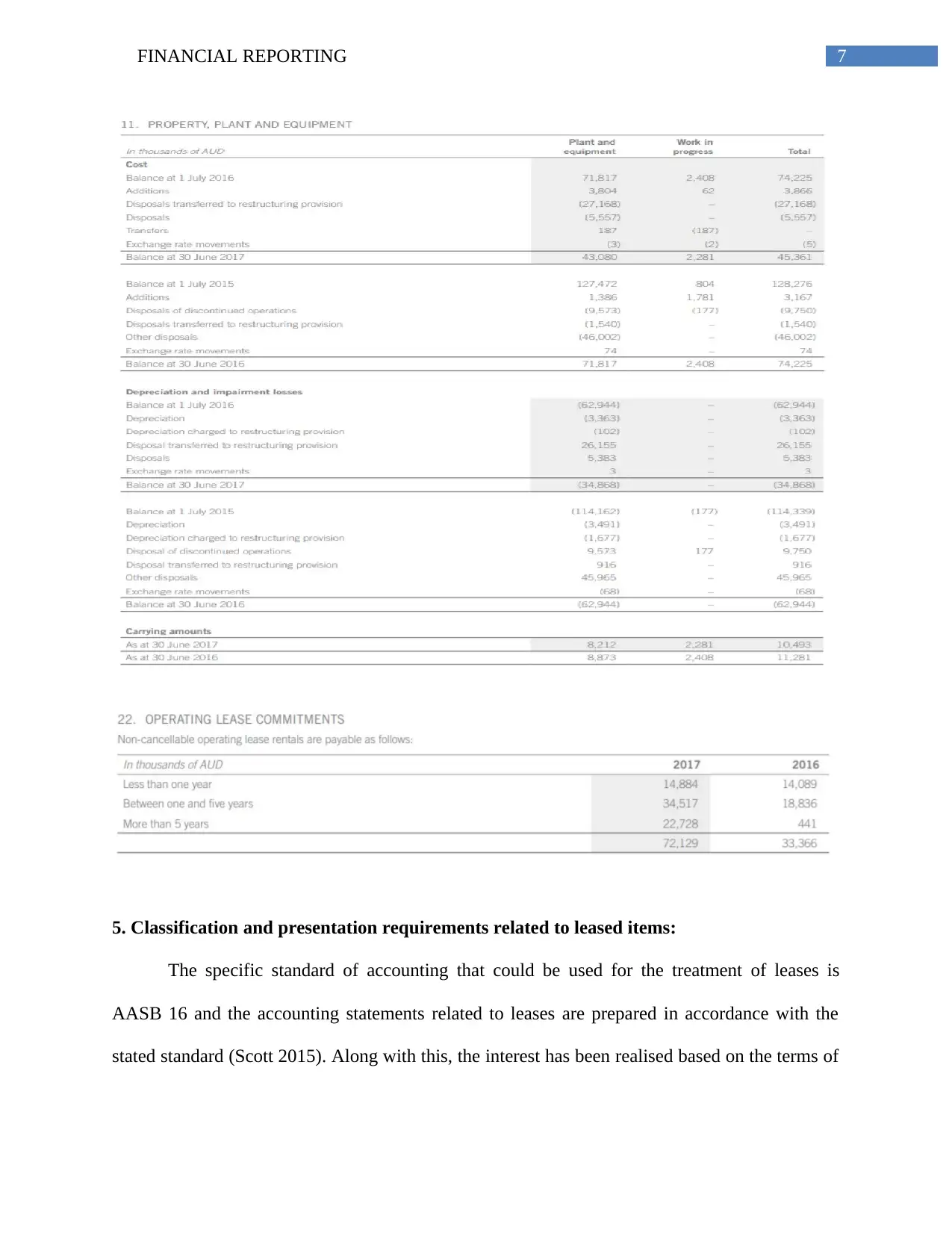
7FINANCIAL REPORTING
5. Classification and presentation requirements related to leased items:
The specific standard of accounting that could be used for the treatment of leases is
AASB 16 and the accounting statements related to leases are prepared in accordance with the
stated standard (Scott 2015). Along with this, the interest has been realised based on the terms of
5. Classification and presentation requirements related to leased items:
The specific standard of accounting that could be used for the treatment of leases is
AASB 16 and the accounting statements related to leases are prepared in accordance with the
stated standard (Scott 2015). Along with this, the interest has been realised based on the terms of
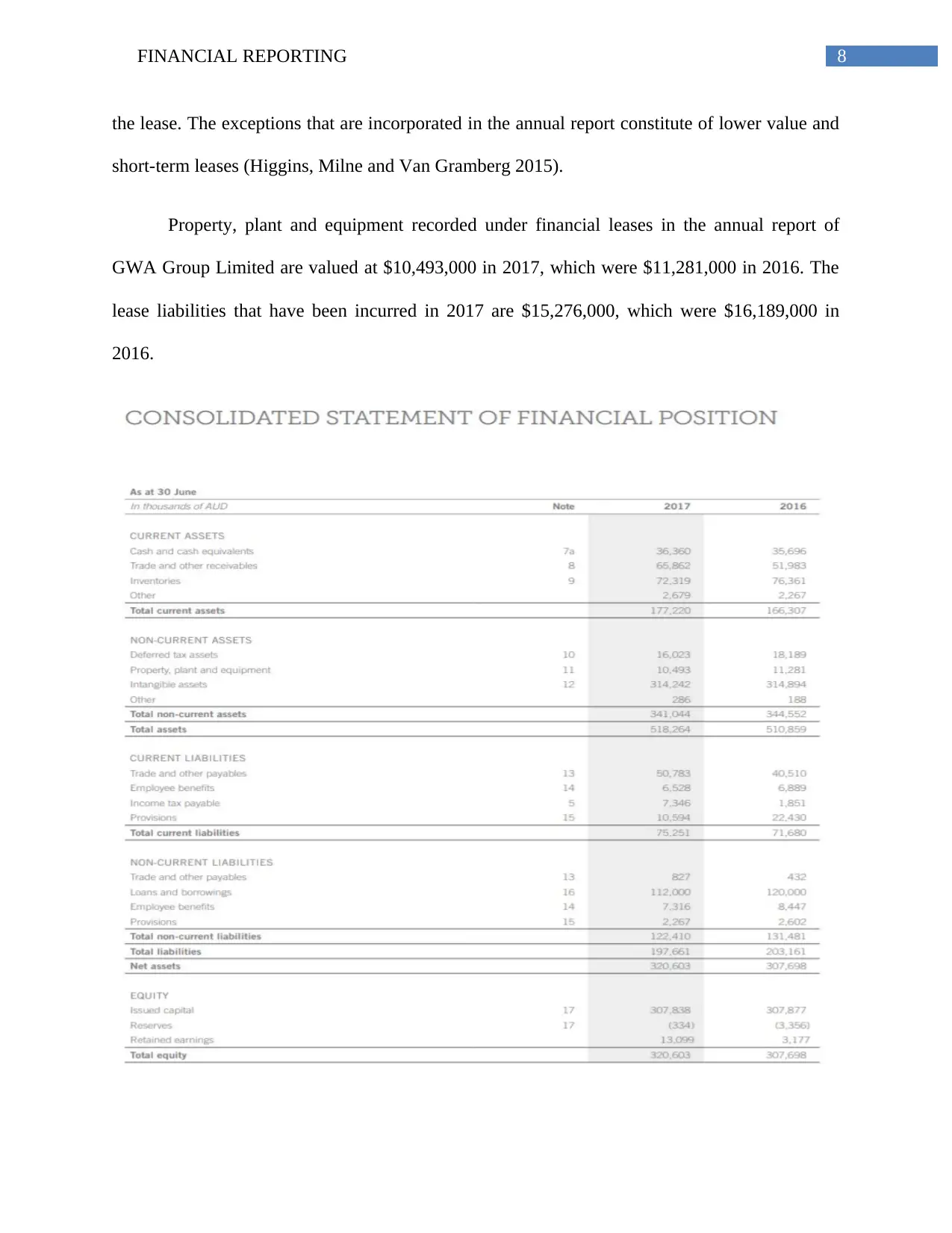
8FINANCIAL REPORTING
the lease. The exceptions that are incorporated in the annual report constitute of lower value and
short-term leases (Higgins, Milne and Van Gramberg 2015).
Property, plant and equipment recorded under financial leases in the annual report of
GWA Group Limited are valued at $10,493,000 in 2017, which were $11,281,000 in 2016. The
lease liabilities that have been incurred in 2017 are $15,276,000, which were $16,189,000 in
2016.
the lease. The exceptions that are incorporated in the annual report constitute of lower value and
short-term leases (Higgins, Milne and Van Gramberg 2015).
Property, plant and equipment recorded under financial leases in the annual report of
GWA Group Limited are valued at $10,493,000 in 2017, which were $11,281,000 in 2016. The
lease liabilities that have been incurred in 2017 are $15,276,000, which were $16,189,000 in
2016.
⊘ This is a preview!⊘
Do you want full access?
Subscribe today to unlock all pages.

Trusted by 1+ million students worldwide
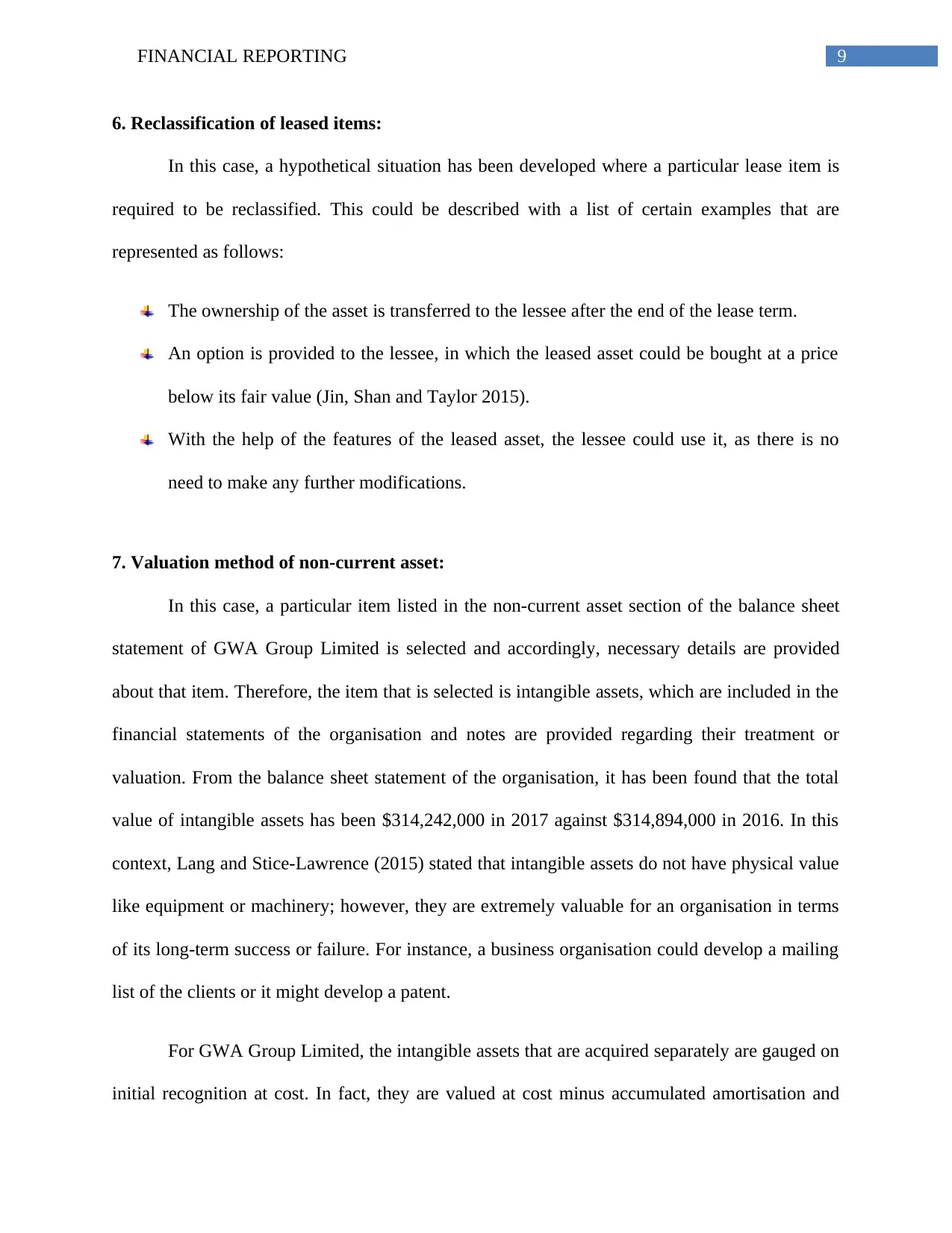
9FINANCIAL REPORTING
6. Reclassification of leased items:
In this case, a hypothetical situation has been developed where a particular lease item is
required to be reclassified. This could be described with a list of certain examples that are
represented as follows:
The ownership of the asset is transferred to the lessee after the end of the lease term.
An option is provided to the lessee, in which the leased asset could be bought at a price
below its fair value (Jin, Shan and Taylor 2015).
With the help of the features of the leased asset, the lessee could use it, as there is no
need to make any further modifications.
7. Valuation method of non-current asset:
In this case, a particular item listed in the non-current asset section of the balance sheet
statement of GWA Group Limited is selected and accordingly, necessary details are provided
about that item. Therefore, the item that is selected is intangible assets, which are included in the
financial statements of the organisation and notes are provided regarding their treatment or
valuation. From the balance sheet statement of the organisation, it has been found that the total
value of intangible assets has been $314,242,000 in 2017 against $314,894,000 in 2016. In this
context, Lang and Stice-Lawrence (2015) stated that intangible assets do not have physical value
like equipment or machinery; however, they are extremely valuable for an organisation in terms
of its long-term success or failure. For instance, a business organisation could develop a mailing
list of the clients or it might develop a patent.
For GWA Group Limited, the intangible assets that are acquired separately are gauged on
initial recognition at cost. In fact, they are valued at cost minus accumulated amortisation and
6. Reclassification of leased items:
In this case, a hypothetical situation has been developed where a particular lease item is
required to be reclassified. This could be described with a list of certain examples that are
represented as follows:
The ownership of the asset is transferred to the lessee after the end of the lease term.
An option is provided to the lessee, in which the leased asset could be bought at a price
below its fair value (Jin, Shan and Taylor 2015).
With the help of the features of the leased asset, the lessee could use it, as there is no
need to make any further modifications.
7. Valuation method of non-current asset:
In this case, a particular item listed in the non-current asset section of the balance sheet
statement of GWA Group Limited is selected and accordingly, necessary details are provided
about that item. Therefore, the item that is selected is intangible assets, which are included in the
financial statements of the organisation and notes are provided regarding their treatment or
valuation. From the balance sheet statement of the organisation, it has been found that the total
value of intangible assets has been $314,242,000 in 2017 against $314,894,000 in 2016. In this
context, Lang and Stice-Lawrence (2015) stated that intangible assets do not have physical value
like equipment or machinery; however, they are extremely valuable for an organisation in terms
of its long-term success or failure. For instance, a business organisation could develop a mailing
list of the clients or it might develop a patent.
For GWA Group Limited, the intangible assets that are acquired separately are gauged on
initial recognition at cost. In fact, they are valued at cost minus accumulated amortisation and
Paraphrase This Document
Need a fresh take? Get an instant paraphrase of this document with our AI Paraphraser
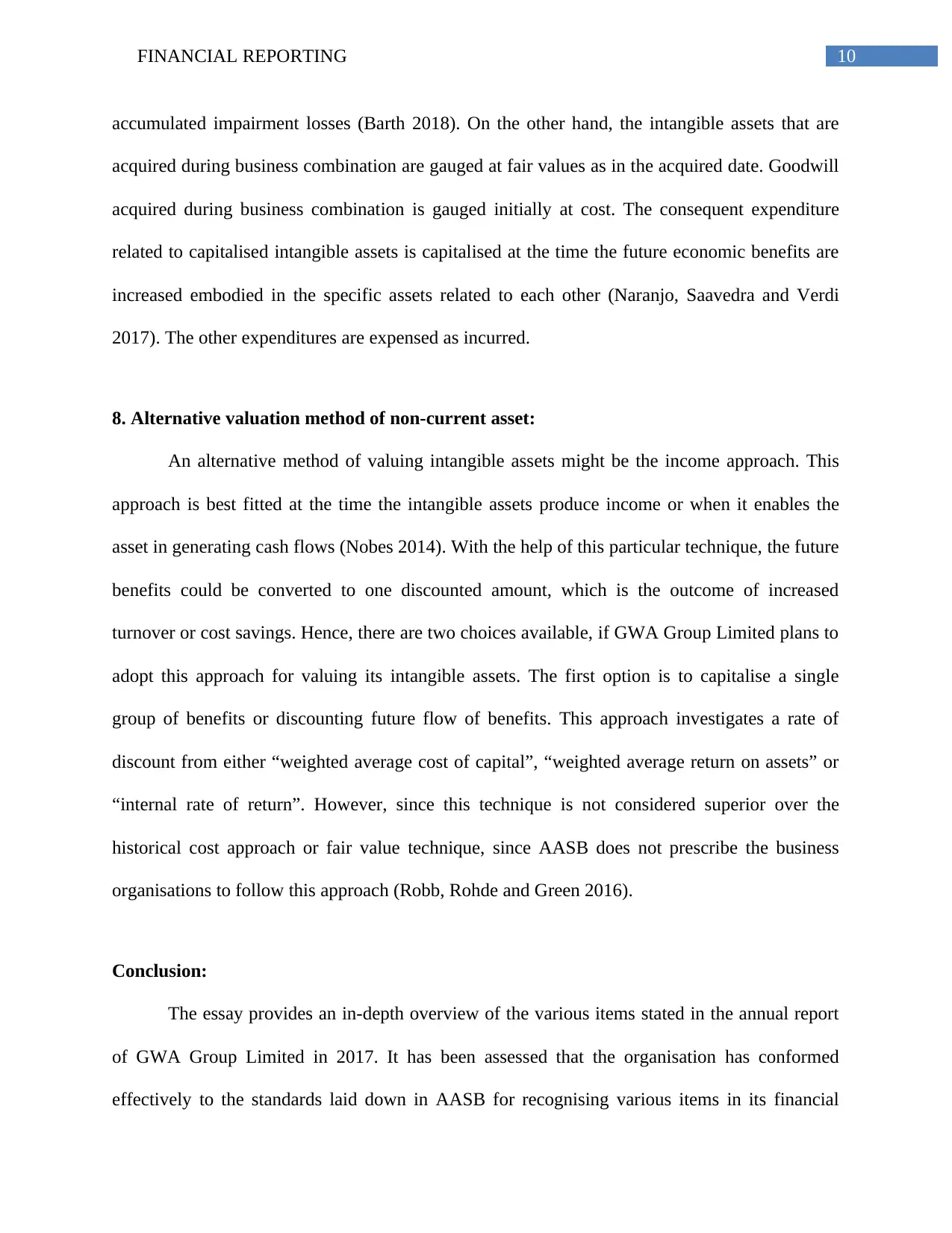
10FINANCIAL REPORTING
accumulated impairment losses (Barth 2018). On the other hand, the intangible assets that are
acquired during business combination are gauged at fair values as in the acquired date. Goodwill
acquired during business combination is gauged initially at cost. The consequent expenditure
related to capitalised intangible assets is capitalised at the time the future economic benefits are
increased embodied in the specific assets related to each other (Naranjo, Saavedra and Verdi
2017). The other expenditures are expensed as incurred.
8. Alternative valuation method of non-current asset:
An alternative method of valuing intangible assets might be the income approach. This
approach is best fitted at the time the intangible assets produce income or when it enables the
asset in generating cash flows (Nobes 2014). With the help of this particular technique, the future
benefits could be converted to one discounted amount, which is the outcome of increased
turnover or cost savings. Hence, there are two choices available, if GWA Group Limited plans to
adopt this approach for valuing its intangible assets. The first option is to capitalise a single
group of benefits or discounting future flow of benefits. This approach investigates a rate of
discount from either “weighted average cost of capital”, “weighted average return on assets” or
“internal rate of return”. However, since this technique is not considered superior over the
historical cost approach or fair value technique, since AASB does not prescribe the business
organisations to follow this approach (Robb, Rohde and Green 2016).
Conclusion:
The essay provides an in-depth overview of the various items stated in the annual report
of GWA Group Limited in 2017. It has been assessed that the organisation has conformed
effectively to the standards laid down in AASB for recognising various items in its financial
accumulated impairment losses (Barth 2018). On the other hand, the intangible assets that are
acquired during business combination are gauged at fair values as in the acquired date. Goodwill
acquired during business combination is gauged initially at cost. The consequent expenditure
related to capitalised intangible assets is capitalised at the time the future economic benefits are
increased embodied in the specific assets related to each other (Naranjo, Saavedra and Verdi
2017). The other expenditures are expensed as incurred.
8. Alternative valuation method of non-current asset:
An alternative method of valuing intangible assets might be the income approach. This
approach is best fitted at the time the intangible assets produce income or when it enables the
asset in generating cash flows (Nobes 2014). With the help of this particular technique, the future
benefits could be converted to one discounted amount, which is the outcome of increased
turnover or cost savings. Hence, there are two choices available, if GWA Group Limited plans to
adopt this approach for valuing its intangible assets. The first option is to capitalise a single
group of benefits or discounting future flow of benefits. This approach investigates a rate of
discount from either “weighted average cost of capital”, “weighted average return on assets” or
“internal rate of return”. However, since this technique is not considered superior over the
historical cost approach or fair value technique, since AASB does not prescribe the business
organisations to follow this approach (Robb, Rohde and Green 2016).
Conclusion:
The essay provides an in-depth overview of the various items stated in the annual report
of GWA Group Limited in 2017. It has been assessed that the organisation has conformed
effectively to the standards laid down in AASB for recognising various items in its financial
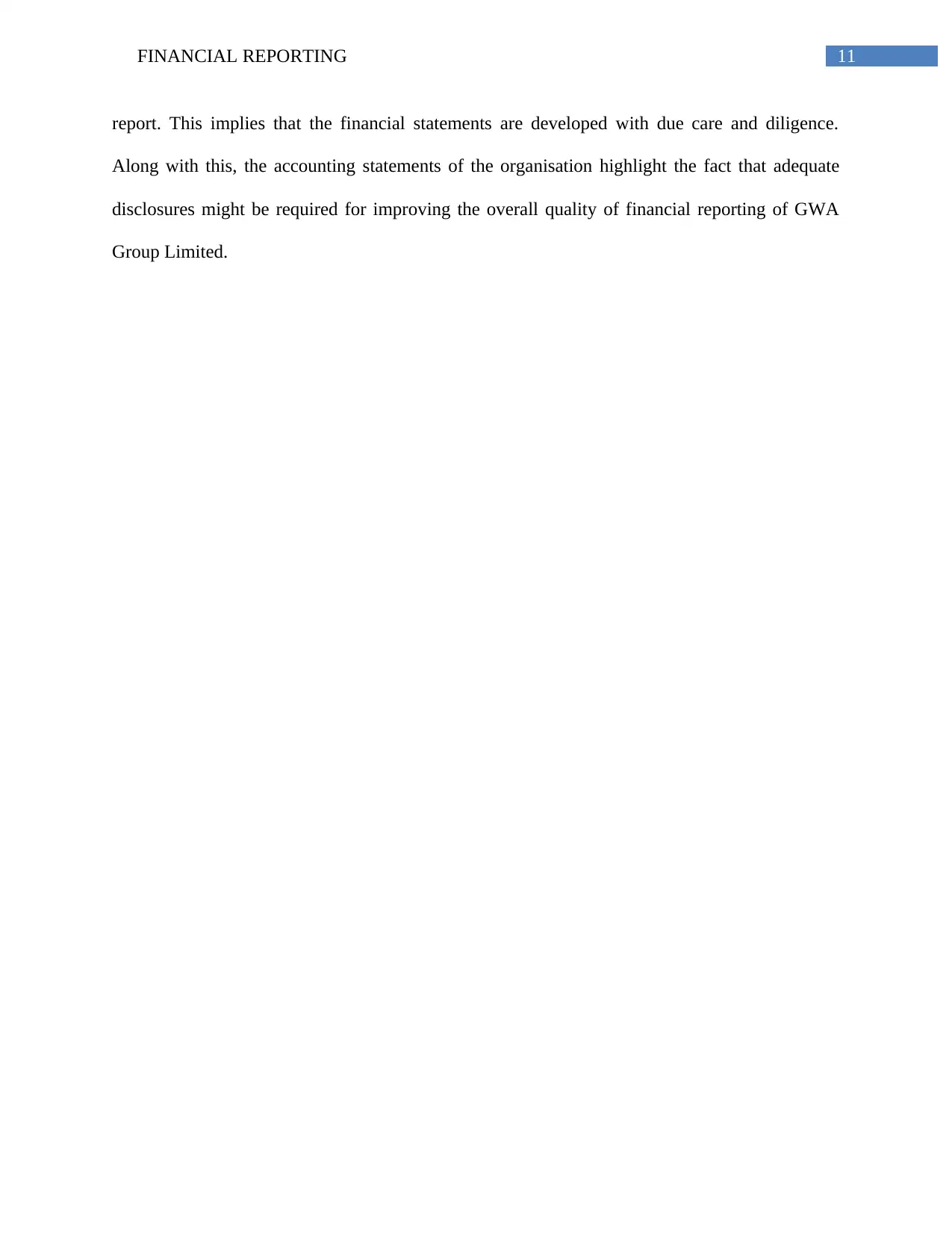
11FINANCIAL REPORTING
report. This implies that the financial statements are developed with due care and diligence.
Along with this, the accounting statements of the organisation highlight the fact that adequate
disclosures might be required for improving the overall quality of financial reporting of GWA
Group Limited.
report. This implies that the financial statements are developed with due care and diligence.
Along with this, the accounting statements of the organisation highlight the fact that adequate
disclosures might be required for improving the overall quality of financial reporting of GWA
Group Limited.
⊘ This is a preview!⊘
Do you want full access?
Subscribe today to unlock all pages.

Trusted by 1+ million students worldwide
1 out of 14
Related Documents
Your All-in-One AI-Powered Toolkit for Academic Success.
+13062052269
info@desklib.com
Available 24*7 on WhatsApp / Email
![[object Object]](/_next/static/media/star-bottom.7253800d.svg)
Unlock your academic potential
Copyright © 2020–2025 A2Z Services. All Rights Reserved. Developed and managed by ZUCOL.




